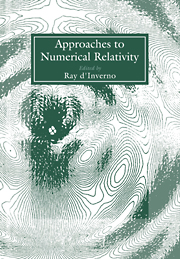Book contents
- Frontmatter
- Contents
- Contributors
- Introduction
- Preface
- PART A THEORETICAL APPROACHES
- PART B PRACTICAL APPROACHES
- Numerical asymptotics
- Instabilities in rapidly rotating polytropes
- Gravitational radiation from coalescing binary neutron stars
- “Critical” behaviour in massless scalar field collapse
- Godunov-type methods applied to general relativistic stellar collapse
- Astrophysical sources of gravitational waves and neutrinos
- Gravitational radiation from 3D gravitational stellar core collapse
- A vacuum fully relativistic 3D numerical code
- Solution of elliptic equations in numerical relativity using multiquadrics
- Self-gravitating thin discs around rotating black holes
- An ADI scheme for a black hole problem
- Time-symmetric ADI and causal reconnection
- The numerical study of topological defects
- Computations of bubble growth during the cosmological quark-hadron transition
- Initial data of axisymmetric gravitational waves with a cosmological constant
- PANEL DISCUSSION
Astrophysical sources of gravitational waves and neutrinos
Published online by Cambridge University Press: 15 December 2009
- Frontmatter
- Contents
- Contributors
- Introduction
- Preface
- PART A THEORETICAL APPROACHES
- PART B PRACTICAL APPROACHES
- Numerical asymptotics
- Instabilities in rapidly rotating polytropes
- Gravitational radiation from coalescing binary neutron stars
- “Critical” behaviour in massless scalar field collapse
- Godunov-type methods applied to general relativistic stellar collapse
- Astrophysical sources of gravitational waves and neutrinos
- Gravitational radiation from 3D gravitational stellar core collapse
- A vacuum fully relativistic 3D numerical code
- Solution of elliptic equations in numerical relativity using multiquadrics
- Self-gravitating thin discs around rotating black holes
- An ADI scheme for a black hole problem
- Time-symmetric ADI and causal reconnection
- The numerical study of topological defects
- Computations of bubble growth during the cosmological quark-hadron transition
- Initial data of axisymmetric gravitational waves with a cosmological constant
- PANEL DISCUSSION
Summary
Abstract. Our project was inspired by the prospect that a new non-electromagnetic astronomy will develop by the end of the century. Projects like Virgo and Ligo will lead to detectors able to detect extra-Galactic and Galactic sources of gravitational radiation. New generation of neutrino detectors like Superkamiokande will be able to detect various Galactic neutrino sources. All these considerations motivated us to study in detail potential Galactic sources of bursts of the gravitational radiation and neutrinos. In this paper, our projects are described in some detail. The advantages and the drawbacks of the numerical technique used in our computer simulations (pseudospectral methods) are discussed. Possible applications of the numerical methods are illustrated by some examples of astrophysical interest: coalescence of two neutron stars, mini-collapse of a neutron star (phase transition) and formation of a black hole due to the collapse of a neutron star.
INTRODUCTION
The main idea, which motivated our project, is that massive stellar cores, involved in supernovae of type II, are not the only collapsing Galactic objects generating bursts of gravitational waves that could be detected by the next generation of gravitational wave detectors. It is quite likely that SNI and SNII are only an optically detectable subset of a larger class of collapse events, which are less spectacular (as far as electromagnetic radiation is concerned) but perhaps quite frequent, and which are able to radiate a conspicuous amount of gravitational radiation.
- Type
- Chapter
- Information
- Approaches to Numerical Relativity , pp. 230 - 246Publisher: Cambridge University PressPrint publication year: 1992
- 2
- Cited by



